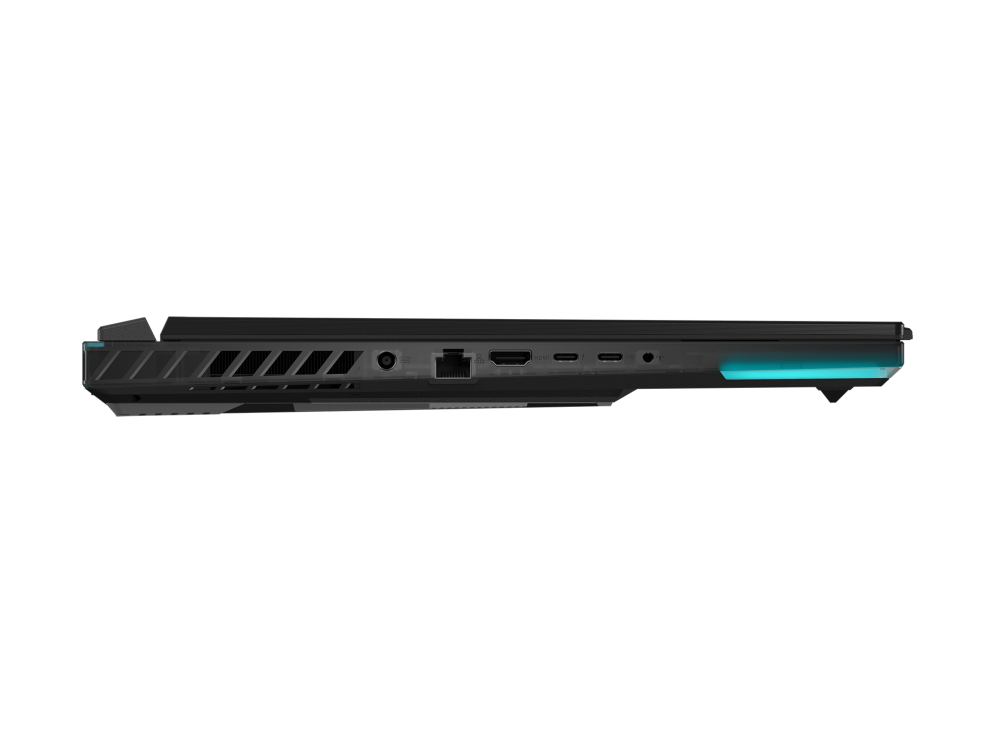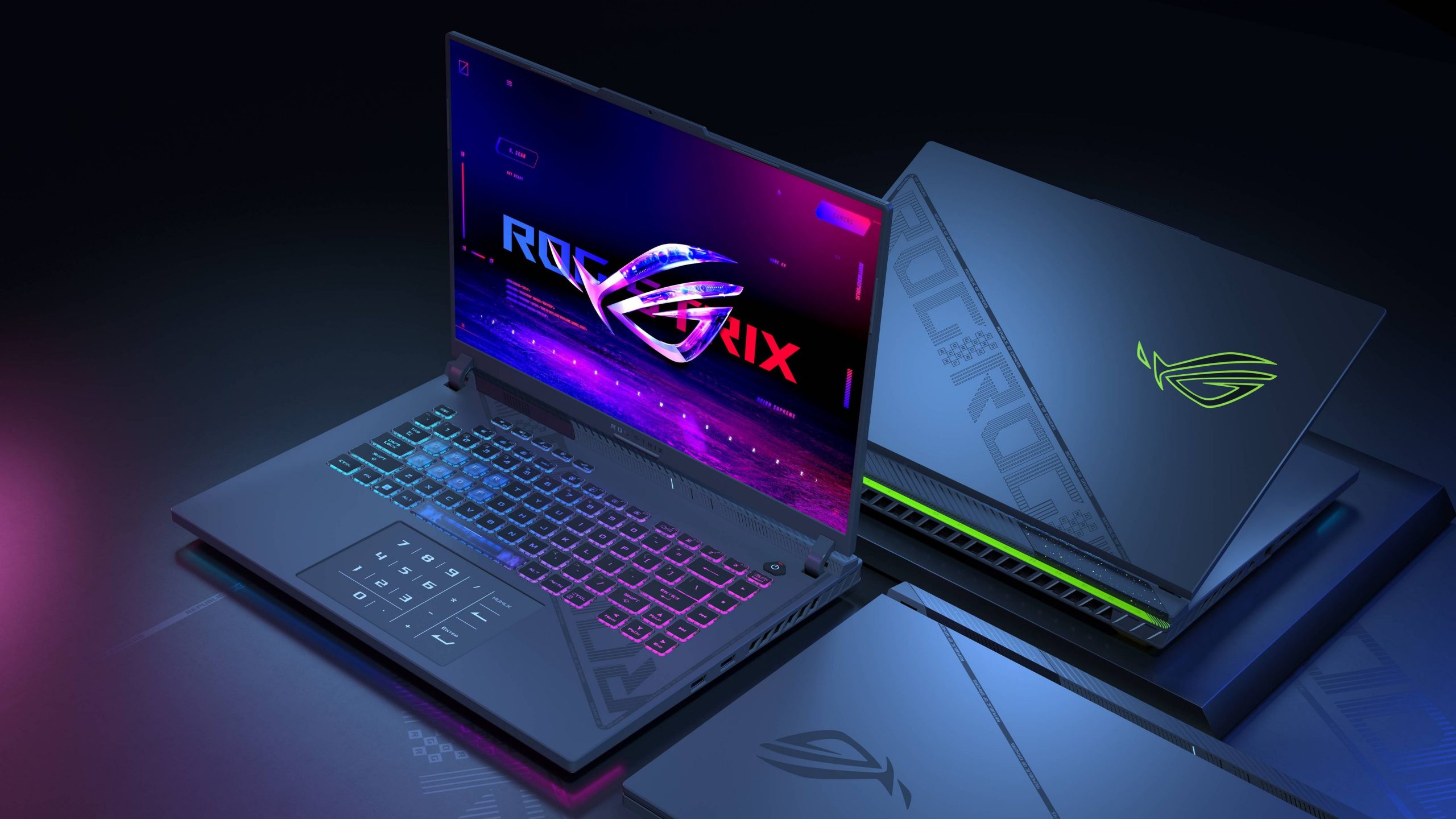The Asus ROG Strix SCAR 18 positions itself as the flagship of the Taiwanese brand’s gaming laptop range, showcasing the latest advancements in components. Powered by a robust 13th-generation Intel Core HX series processor and equipped with a powerful Nvidia GeForce RTX 4080, it delivers top-notch performance for demanding gamers. The ROG Strix Scar, the pinnacle of the ROG high-end range, stands out with its generous 18-inch screen (model G834JZ), providing an unparalleled immersive experience.
Technical Specifications of Asus ROG Strix SCAR 18
| Detail | Specification |
| Screen Size | 18 inches |
| Screen Resolution | 2560 x 1600 |
| Dimensions (Width, Length, Thickness) | 29.4 x 399 x 30.8 mm |
| Weight | 3.1 kg |
| Processor | Intel Core i7-13980HX |
| RAM | 16 GB |
| Graphics Card | Nvidia GeForce RTX 4080 175 W |
| Video Memory | 12 GB |
| Operating System | Windows |
| Panel Type | IPS |
| Matte Screen | Yes |
| Touch Screen | No |
| Hybrid | No |
| Cooling | Fan |
| Repairability Score | 8/10 |
Presentation
The ROG Strix Scar 18 embodies Asus’ expertise in gaming laptops. In 2023, a transition from a 17.3-inch to an 18-inch screen took place while maintaining the same form factor. This parallels the shift from 15.6 to 16 inches seen previously. The ROG Strix Scar 18 retains its reputation by housing top-of-the-line internal components, featuring a 13th-generation Intel Core HX processor—derived from desktop PC models. Additionally, users have the option to choose between a GeForce RTX 4080 or 4090, both with a maximum power envelope of 175 W. The ROG Strix Scar 18 is priced at US$2,374.99 to US$2,499.99 with the GeForce RTX 4080, and an additional $1100 for the GeForce RTX 4090.
Construction
The design of the ROG Strix Scar 18 sees minimal changes compared to its predecessor, the ROG Strix Scar 17, tested in 2022. The chassis is still made of plastic with a convincing anti-fingerprint treatment. The iconic ROG logo with backlighting is found on the lid, and a second LED strip is now present at the rear, just above the large air vent. Opening the laptop reveals a new interior design with a transparent effect towards the screen. The diagonal ROG strip is still a prominent feature, while the ROG Keystone (NFC key for saving user profiles) is no longer present.

The keyboard is individually backlit with RGB lighting. However, Asus opted not to include a mechanical keyboard, unlike some competitors in this price range. The typing experience is nevertheless satisfactory, though it may not offer the same responsiveness and precision as a mechanical keyboard. The touchpad is notably spacious and provides smooth navigation. Windows gestures work seamlessly, and the left/right clicks are well-defined.
Connectivity
Most of the ports are located on the left side of the Scar 18, while the rear is dedicated entirely to the cooling system. Here, you’ll find the charging port, a USB 4.0, a Thunderbolt, an RJ45 2.5G, an HDMI 2.1, and a headphone-microphone jack. Two USB 3.2 ports (10 Gb/s) are also available on the right side of the chassis for connecting peripherals. The Intel AX211 chip handles wireless connectivity, supporting Wi-Fi 6E at 2400 Mb/s and Bluetooth 5.3. Asus chose not to opt for a Killer chip. The webcam makes a return with a 720p sensor, though its quality falls short of expectations for a laptop in this price range.

Cooling System
The Scar 18 boasts a completely revamped cooling system, housing three fans, two smaller radiators on each side of the laptop, and an enormous radiator spanning the entire width of the chassis. Seven heat pipes are responsible for transferring heat from the processor and graphics card to the radiators. The thermal performance is impressive, with the QWERTY and arrow keys staying cool, while the area between the keyboard and screen can reach nearly 53°C. It’s advisable to avoid placing fingers near the air vents, which can exceed 50°C, and even close to 62°C at the back of the laptop.

Performance of Asus ROG Strix Scar 18
The Asus ROG Strix Scar 18 (G834JZ) provided by Asus is equipped with an Intel Core i9-13980HX (24C/32T) processor capable of reaching 5.6 GHz. It is accompanied by 32 GB of DDR5 RAM and a 1 TB SSD. With the most powerful Core i9, the ROG Strix Scar 18 achieves a performance score of 272, surpassing the Medion Erazer Beast X40’s Core i9-13900HX (248) by 10%. The arrival of the AMD Ryzen 7045HX processors will be awaited for true competition.

This commendable result is also attributed to the frequencies achieved by the Core i9-13980HX. During our HandBrake encoding test, this processor averages 4.1 GHz on the P-Cores and 3.3 GHz on the E-Cores, all with an average power consumption of 133 W. The 1 TB Samsung NVMe SSD achieves speeds of 7 GB/s for reading and slightly over 5 GB/s for writing, more than sufficient for Windows and gaming use. Those using the Scar 18 for video editing will be pleased to swiftly handle their footage.

Related: Best Lenovo Laptop of 2023
Games
For graphics, Asus has equipped the ROG Strix Scar 18 (G834JZ) with an Nvidia GeForce RTX 4080 with 12 GB of video memory. The power envelope is pushed to its maximum at 175 W, with 25 W coming from the Dynamic Boost option. The gaming performance index of the ROG Strix Scar 18 with its GeForce RTX 4080 is 348, outperforming the MSI Raider GE76 and its GeForce RTX 3080 Ti by 38%. The Medion Erazer Beast X40 with GeForce RTX 4090 is only 11% more powerful. The Scar 18 even approaches the Blade 16 and its RTX 4090, which score an index of 365.

In Full HD with all details set to maximum, the Scar 18 handles our panel of games with nearly 150 FPS, with only Cyberpunk 2077 putting up a fight at 88 FPS. Activating ray tracing causes a one-third drop in frame rate, while enabling DLSS or FSR brings back a high frame rate. Finally, enabling DLSS 3 in Cyberpunk 2077 generates 140 FPS. This hints at good performance in the native 2560 x 1600 pixel resolution of the Scar’s 18-inch screen.

Transitioning to 2560 x 1600 pixels decreases the frame rate by an average of 32% in our tested game panel. However, frame rates still comfortably stay above 60 FPS. When they don’t, enabling DLSS restores the desired fluidity. The ROG Strix Scar 18 is thus capable of playing under excellent conditions, even in its native 2560 x 1600 pixel resolution.

Related: Review of Lenovo Thinkpad Z13
Display of Asus ROG Strix Scar 18
The display of the Asus ROG Strix Scar 18 features an 18-inch IPS panel provided by BOE. It displays 2560 x 1600 pixels at 240 Hz and benefits from G-Sync technology, reducing stuttering and tearing by synchronizing the frame rate rendered with the pixel refresh rate. This model doesn’t incorporate mini-LED backlighting or an OLED panel, as such displays in 18 inches are not yet widespread.

Under our probe, the delta E of 1.9 is well below the threshold of 3, beyond which color discrepancies become perceptible to the eye. The displayed color temperature is 6590 K, very close to the ideal value of 6500 K. However, the contrast is relatively low at 1004:1 — blacks tend to lean towards gray rather than deep black like in an OLED or mini-LED panel.
The maximum brightness is 430 cd/m², an average value, coupled with low reflectance from the matte panel which only reflects 17.8% of light. Lastly, the display of the Asus ROG Strix Scar 18 is particularly responsive with a measured persistence of only 7 ms.
Audio
The audio aspect of the ROG Strix Scar 18 consists of four speakers — two beneath the chassis and two beneath the screen. Our evaluation reveals substantial volume with well-defined stereo, but still lacking in bass, a characteristic of gaming laptops. However, this is less pronounced compared to many other models. It’s worth noting a slight boxy effect due to the predominantly plastic chassis.
The headphone output is of good quality with ample levels, capable of handling high-impedance headphones. Distortion is particularly low, crosstalk is limited, and the dynamic range is more than sufficient for full music enjoyment.
| ASUS ROG SCAR 18 | Average of Laptops Reviewed | |
| Output level | 221 mVRMS | 160 mVRMS |
| Distortion + Noise | 0,016 % | 0,015 % |
| Dynamic Range | 95 dB | 100 dB |
| Diaphonies | -62 dB | -64 dB |
Read Also: Review of ASUS ROG Flow X13
Asus ROG Strix Scar 18 Mobility / Battery Life
Admittedly, the ROG Strix Scar 18 is a hefty beast. It measures 39.9 x 29.4 cm with a thickness of 3 cm, larger than its predecessor by an additional 1.2 cm in depth. Consequently, it barely fits into our backpack that has accommodated numerous gaming laptops before. It doesn’t fare better in weight, as it weighs 3.1 kg, plus an additional 1 kg for its 330 W charger.

Despite a 90 Wh battery, the Scar 18 only lasted 5 hours and 26 minutes in video playback on Netflix and the Chrome browser (screen at 200 cd/m², backlighting and Bluetooth off). This modest battery life performance can be attributed to the appetite of the Core i9-13980HX, derived from a 13th-generation Intel desktop processor known for its energy consumption.
Related: ASUS ROG Strix SCAR 16 2023 Gaming Laptop Review
Pros and Cons of Asus ROG Strix Scar 18
Pros
Powerful processor.
Effective cooling system.
RTX 4080 performance.
Cons
Low-contrast display.
No mechanical keyboard.
Average webcam.
Noise in Turbo mode.
Asus ROG Strix Scar 18 Review

Conclusion
The Asus ROG Strix Scar 18 aligns perfectly with Republic of Gamers’ gaming laptops. It suffers from no significant flaws, except for its low-contrast display. One could argue it lacks a certain flair, but this machine remains extremely effective, both in terms of performance and cooling.





